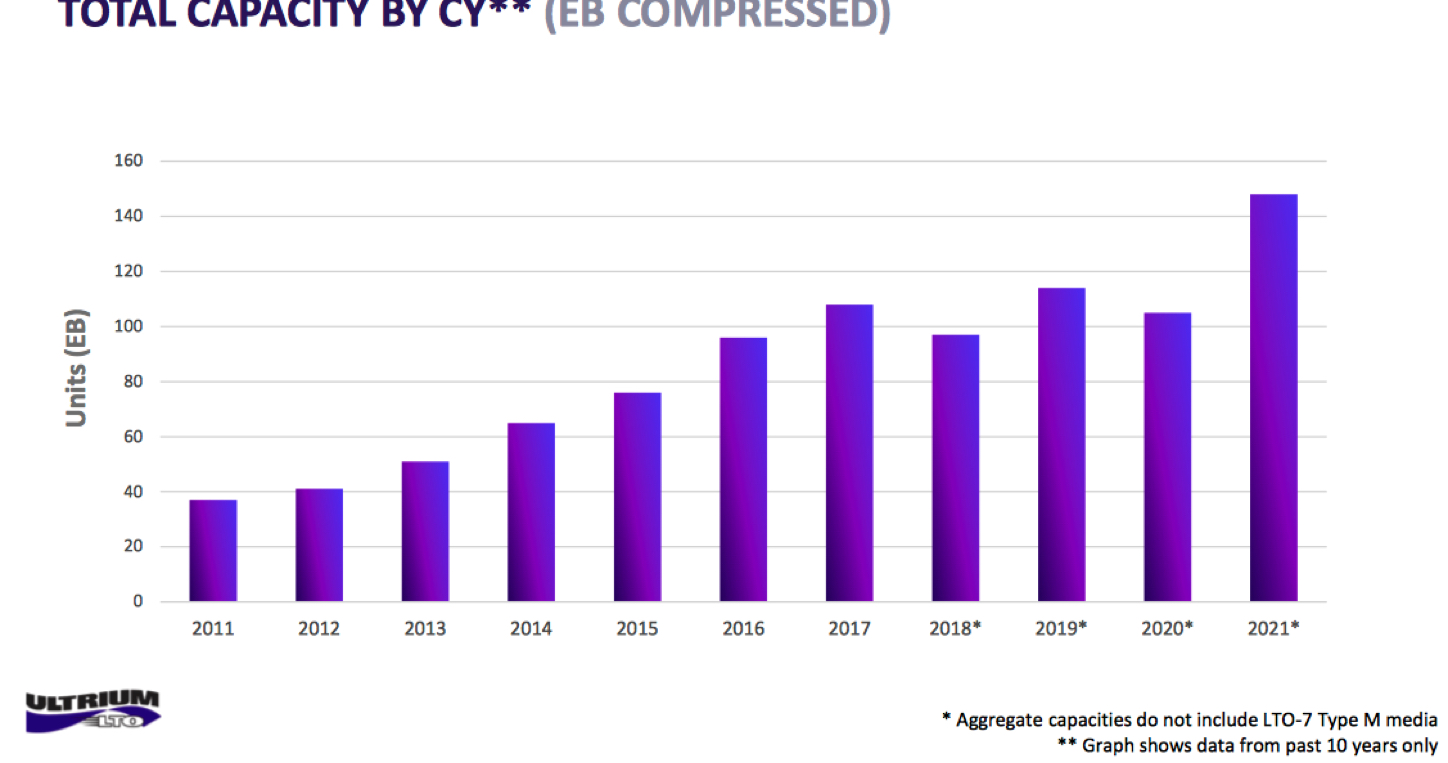Tape Storage Shipments Increase 40% in 2021
Tape storage is dead. Long live tape storage!
As the market's thirst for storage increases on the back of massive amounts of data production, tape as a storage medium is still chugging along. Far from being abandoned, shipments for tape-based storage media soared 40% in 2021, achieving an impressive 148 Exabytes (155 million TB) of total storage space sent to clients, according to tape providers like IBM, HPE and Quantum.. At the same time, unit shipments have decreased on the back of increased per-tape densities, which can now achieve a whopping 54 TB per cartridge thanks to the backwards-compatible LTO-9 technology.


"Despite the significant business disruptions and uncertainty in 2021, LTO tape capacity shipments achieved the largest increase since 2006, surpassing the previous record set in 2019," said Patrick Osborne, general manager and vice president at HPE storage. "We’re continuing to see organizations return to tape technology, seeking out storage solutions that offer high capacity, reliability, long term data archiving and stronger data protection measures, especially as threats to cybersecurity soar."
Increasing amounts of produced data means that storage must scale along with it. It's estimated that the world's population created around 79 zettabytes (79 billion terabytes) worth of data in 2021, with projections placing that number at a mind-boggling 181 Zettabytes by 2025. Booms in the creator economy, improvements in capture technology, and increased deployment of AI and machine-learning systems are likely to be the biggest contributors to this growth scenario.
Tapes offer some advantages over their other storage medium counterparts — advantages which compound alongside the total storage footprint. Besides being lower power, they're easier to maintain, usually provide higher data longevity than other popular storage mediums (such as HDDs and SSDs), consume less resources when scaling is required, and perhaps more importantly, offer increased protection against ransomware attacks due to their cold storage, offline, and offsite usage.
“LTO tape is arguably the lowest-cost, simplest method of achieving ransomware recovery best practices,” said Phil Goodwin, research vice president at IDC. “Ransomware and malware are threats that will not go away. Magnetic tape is an established, understood, and proven technology that can be an invaluable tool for defeating ransomware.”
As the number and gravity of ransomware attacks increases, companies with large data storage requirements are likely revisiting their backup strategies, with tape offering itself up as the affordable, last line of defense in the 3-2-1-1 backup rule (three copies of data stored on two different storage mediums, with one off-site and one (tape) that is completely offline.
Despite these benefits, the average person — and even enthusiasts — likely wouldn't want to adopt tape storage for their own purposes. This because using tapes to store data comes with trade-offs in latency and throughput that wouldn't make for a great user experience, at least when it comes to frequently accessed data. Accessing a tapes' contents must be done sequentially, adding to the storage's seek times. But in some very specific scenarios for especially prolific content creators, tape might be the best, final level of backup storage.
Get Tom's Hardware's best news and in-depth reviews, straight to your inbox.

Francisco Pires is a freelance news writer for Tom's Hardware with a soft side for quantum computing.
-
plateLunch So what kind of tape drives to they use?Reply
This article made me look in my closet and I still have a QIC-40 and Travan tape drive along with some unopened cartridges. Just have to fire up my old Core 2 Duo machine and I should be back in business. -
spunner5 Generally speaking "LTO" is the most common tape for most businesses. Real world capacities are considerably less than the "54TB" quoted, as compression is never as good and barely increases over the native capacity (i.e. LTO-9 = 18TB per cartridge), typically due to the fact that most data is already compressed. Also note that infrastructure needs to be upgraded as well to be able to reliably stream data to an LTO-9 drive without pause. New server, new SAS or Fibre HBA, etc., and the temp/humidity must be within limits, without sudden changes (i.e. <5% per hour on RH). Careful planning is required, as we all must realize that this is a thin-film, removable-medium that is susceptible to the world you run it in!Reply -
Kamen Rider Blade My main issue is that LTO is a Single-Reel type Tape Cassettes istead of classic Dual-Reel Type Cartridges like VHS/Audio Tape Cassettes of yester year.Reply
There are so many fundamental issues with Single-Reel type Tape Cassettes should things go wrong compared to the easier to fix Dual-Reel Tape Cassettes.